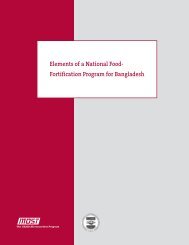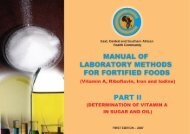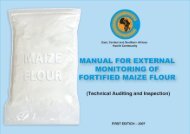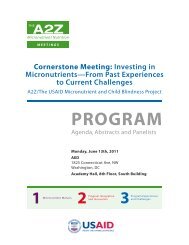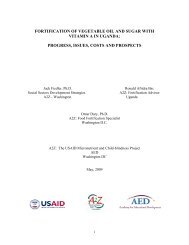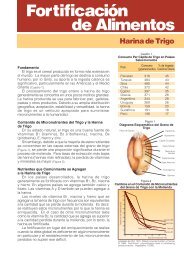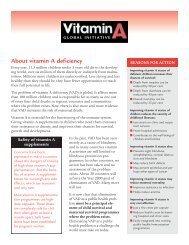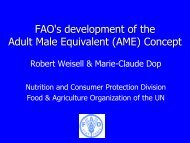manual of methods for determining micronutrients in fortified foods
manual of methods for determining micronutrients in fortified foods
manual of methods for determining micronutrients in fortified foods
Create successful ePaper yourself
Turn your PDF publications into a flip-book with our unique Google optimized e-Paper software.
B. Determ<strong>in</strong>ation <strong>of</strong> thiam<strong>in</strong> <strong>in</strong> flours by high-per<strong>for</strong>mance liquid<br />
chromatography<br />
I. References<br />
Rettenmaier R, Vuilleumier JP and Muller-Mullot W. Determ<strong>in</strong>ation <strong>of</strong> Vitam<strong>in</strong> B1 <strong>in</strong> Complete<br />
Feeds. In: Keller, H.E. Analytical Methods <strong>for</strong> Vitam<strong>in</strong>s and Carotenoids <strong>in</strong> Feeds. Animal Nutrition<br />
and Health Vitam<strong>in</strong>s and F<strong>in</strong>e Chemicals Division, Roche. Switzerland. pp 23-26<br />
II. Pr<strong>in</strong>ciple<br />
Thiam<strong>in</strong> is extracted <strong>in</strong> an autoclave with diluted sulfuric acid. After enzyme hydrolysis, thiam<strong>in</strong><br />
is oxidized with potassium ferricyanide <strong>in</strong> sodium hydroxide to <strong>for</strong>m the thiochrome, which is<br />
fluorescent. The extract is <strong>in</strong>jected <strong>in</strong>to a HPLC onto a reverse phase column (C18) with fluorescence<br />
detection: excitation at 370 nm and emmision at 430 nm.<br />
Recovery <strong>of</strong> Thiam<strong>in</strong> <strong>in</strong> Infant Formula 1849 (NIST) was 95.8 % as measured <strong>in</strong> the CPHL Laboratory.<br />
III. Critical po<strong>in</strong>ts and precautions<br />
Thiam<strong>in</strong> is labile to light and heat. In acid medium, below pH 5.5, thiam<strong>in</strong> is more heat-resistant,<br />
whereas is unstable <strong>in</strong> alkal<strong>in</strong>e and neutral medium. Samples and standard solutions must be protected<br />
from light and a th<strong>in</strong> layer <strong>of</strong> liquid paraff<strong>in</strong> is added dur<strong>in</strong>g autoclav<strong>in</strong>g to protect from heat.<br />
The oxidiz<strong>in</strong>g agent must be prepared freshly, right be<strong>for</strong>e the reaction is carried out. The reaction to<br />
<strong>for</strong>m the thiochrome must be done a few m<strong>in</strong>utes be<strong>for</strong>e <strong>in</strong>ject<strong>in</strong>g <strong>in</strong> the HPLC to avoid underestimat<strong>in</strong>g<br />
thiam<strong>in</strong>e content due to losses caused by the basic pH <strong>of</strong> the oxidiz<strong>in</strong>g agent.<br />
Prior to <strong>in</strong>ject<strong>in</strong>g standards and samples <strong>in</strong> the <strong>in</strong>jection valve, the column must be stabilized with the<br />
mobile phase. At the end <strong>of</strong> the run, r<strong>in</strong>se the column thoroughly with HPLC-water to elim<strong>in</strong>ate all<br />
salt residues from the mobile phase. Then, wash it with methanol. NEVER leave the mobile phase<br />
<strong>in</strong> the column. Follow the wash<strong>in</strong>g protocol recommended <strong>for</strong> the column used.<br />
IV. Equipment and materials<br />
• Autoclave 121-123°C<br />
• Agitator Vortex type<br />
• Analytical balance (± 0.0001 g)<br />
• Water bath (40°C)<br />
• HPLC system<br />
− Pump operat<strong>in</strong>g cont<strong>in</strong>uously at 1.0-2.0 mL/m<strong>in</strong> with a flow precision <strong>of</strong> ± 1% or better<br />
− Injector. A <strong>manual</strong> <strong>in</strong>jector or auto sampl<strong>in</strong>g <strong>in</strong>jector with a 100 μL fixed loop hav<strong>in</strong>g a typical<br />
sampl<strong>in</strong>g precision <strong>of</strong> ±0.25% or better<br />
− Reverse-phase C18 column, 5µm (4.6x150 mm)<br />
− Fluorescent detector: Excitation wavelength: 370 nm; emission wavelength: 430 nm.<br />
• Volumetric flasks (25, 100 and 1000 mL)<br />
• Beakers (25, 100 and 1000 mL)<br />
- 43 -





